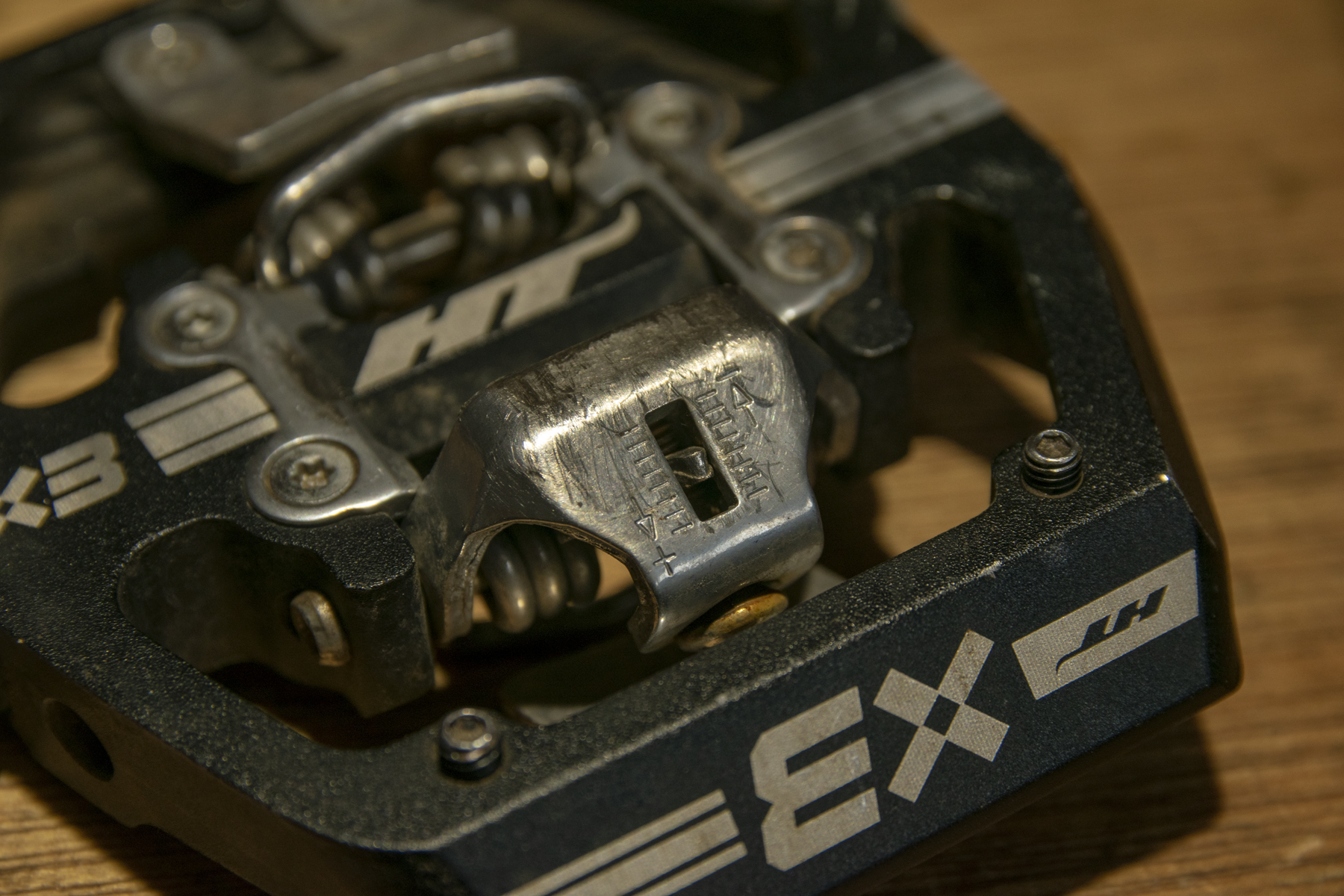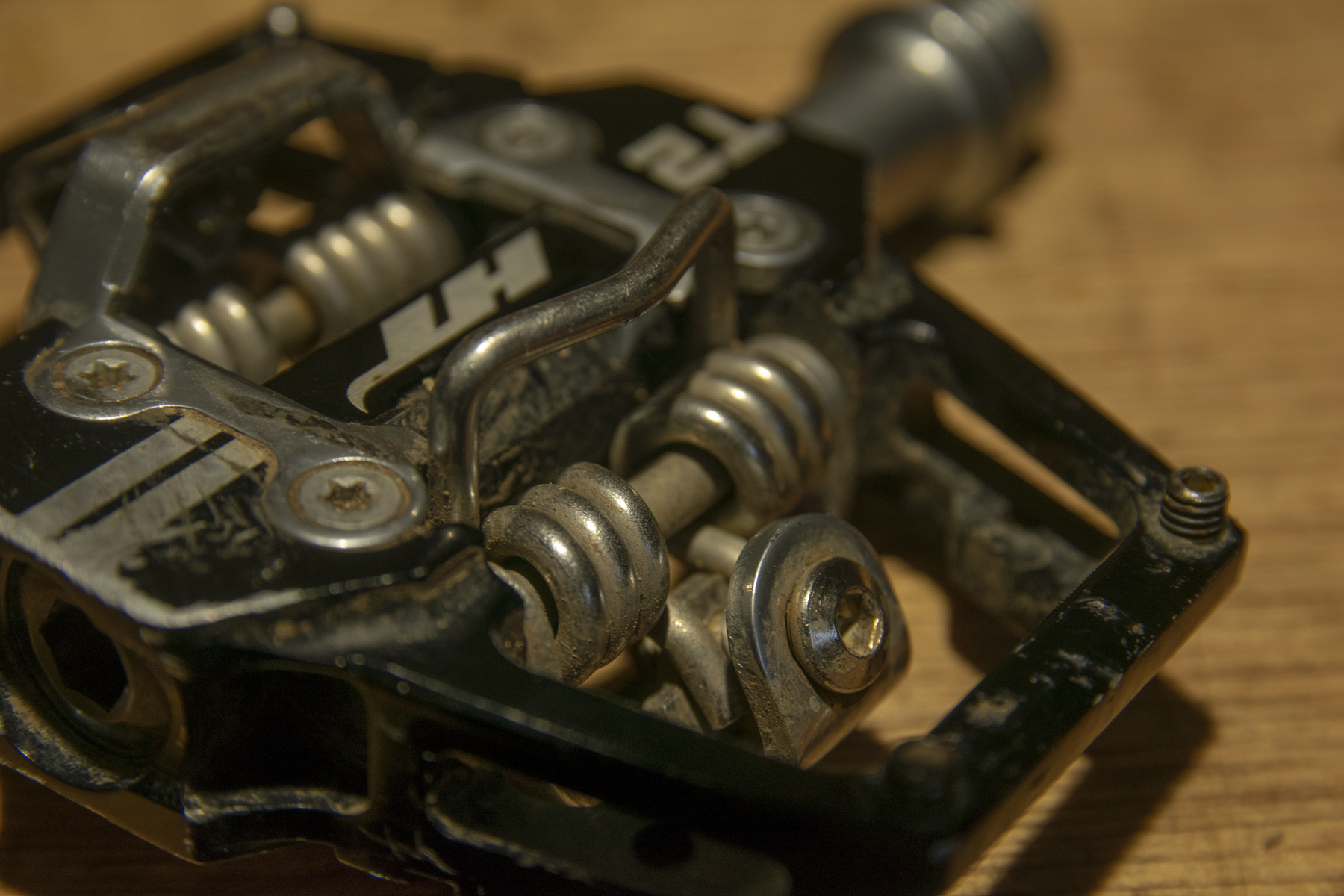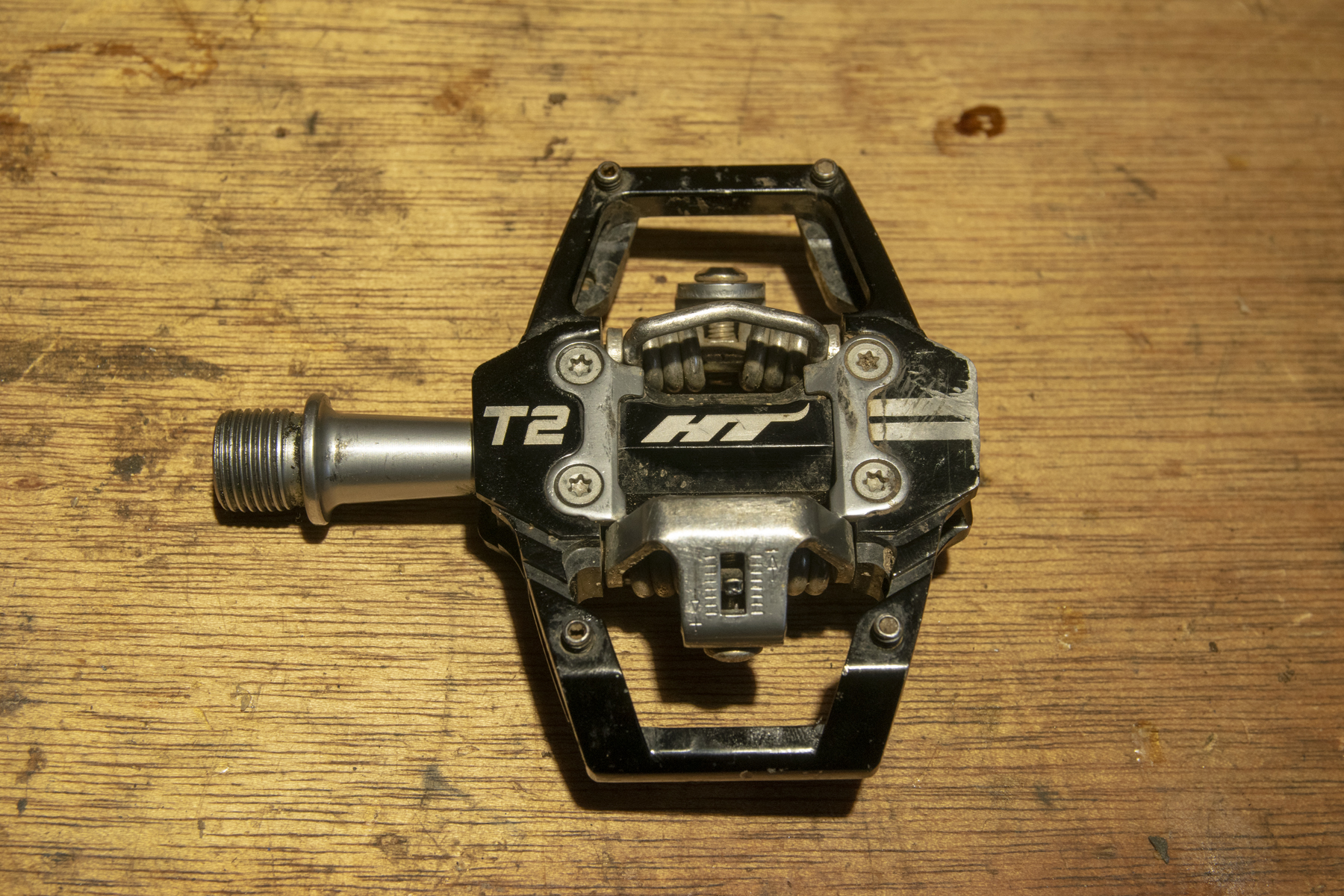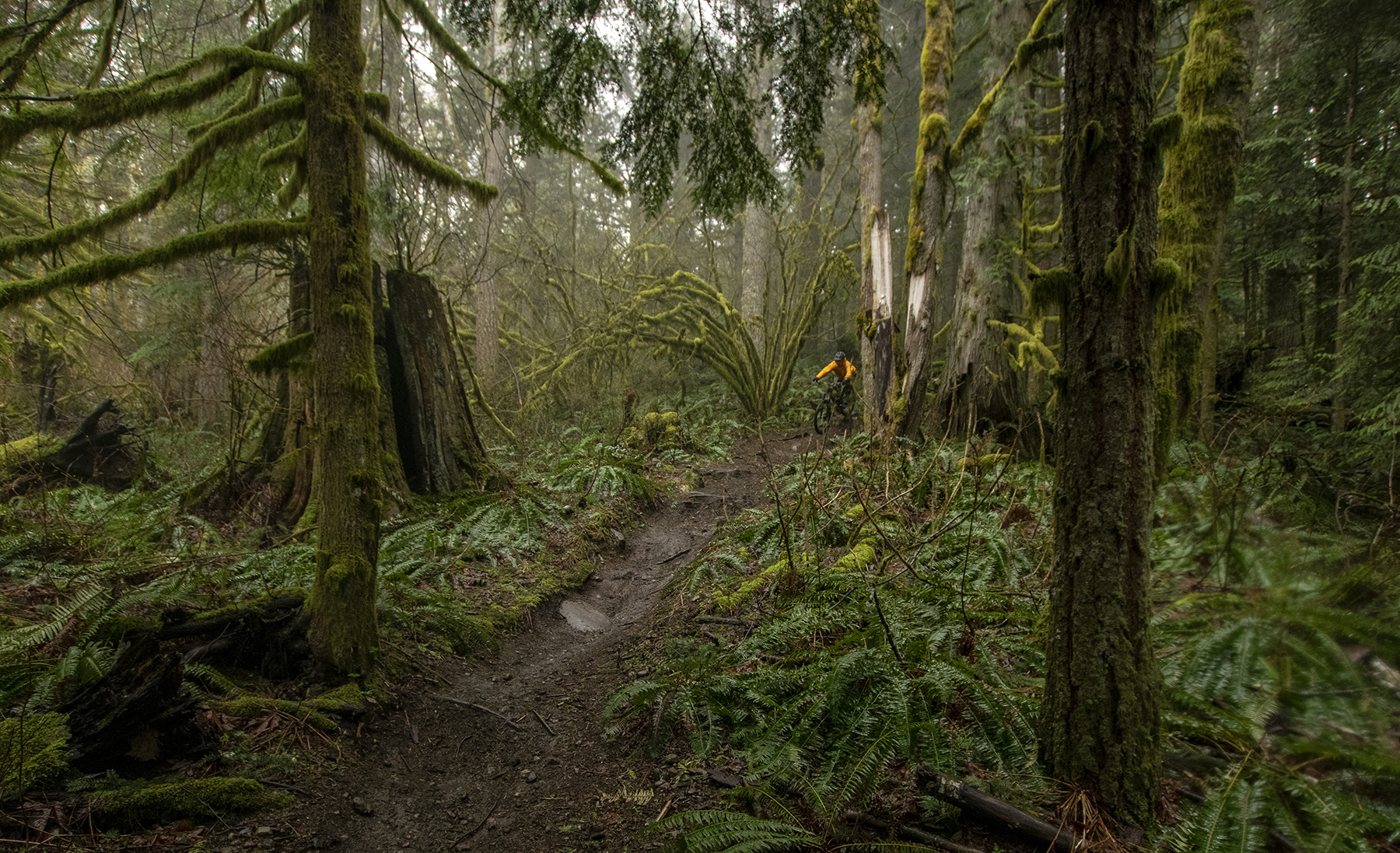HT T2 & X3 Pedals
MSRP:
- T2: $145
- X3: $179
Test Location: Washington, Oregon, Northern California, British Columbia
Test Duration: 6 months
Reviewers: 6’, 175 lb / 183 cm, 79.1 kg
Blister’s Measured Weight per Pedal:
- T2: 189 and 189 g
- X3: 234 and 234 g
Shoes used: Specialized 2FO DH, Shimano AM903, Fizik Terra Artica GTX, Crankbrothers Mallet Boa

Intro
New gear is exciting, but we’re also big fans of not fixing things that aren’t broken, so when HT announced that the new versions of their Trail and DH clipless pedals — the T2 and X3 — would replace the T1 and X2, I was both intrigued and mildly concerned. The T1 and (especially) the X2 had been my personal favorites in their respective classes for years, and while the updates that HT was making appeared to be more subtle refinements than a dramatic overhaul, I had very few complaints about the older pedals, so any changes to them were at least potentially cause for concern.
It turns out that I need not have worried, because HT has done a great job of making a few subtle improvements to the pedals while mostly just keeping everything that I liked about their predecessors. So what exactly sets the T2 and X3 apart from each other, what differentiates them from the rest of the market, and how have they been tweaked compared to the earlier versions? Let’s dig in.

Design
The T2 and X3 (and the M2 XC pedal, which I haven’t tried) share the same core clipless mechanism, with the size and shape of the platform that surrounds it setting the two apart. The mechanism looks a bit like a hybrid between a modern Shimano SPD pedal and a Time one, with a rear retaining bar that contains a spring-tension adjuster and indicator that looks decidedly SPD-like, and a wire bail for the forward half of the clipless mechanism that more closely resembles a Time pedal. That said, Time’s wire bails are straight across the width of the pedal, whereas the HT ones come to a point in the middle, which I think plays a subtle but important role in how they perform — more on that in a minute.


On the standard versions of the T2 and X3, both the front and rear portions of the clip mechanism spring open to help the cleat enter / release; HT also makes an “SX” version of the T2, meant for BMX race use, which adds a little hook around the wire bail at the front of the clipless mechanism to keep it from moving. This, in effect, simply increases the release tension by forcing one spring to handle all the movement rather than letting it be split across both. I’ve only tried the SX versions of the prior-generation T1 and X2, but compared to the standard versions of those pedals, the only noticeable difference was the change in release tension range, and I’d expect the same to be true for the T2 and X3.

HT’s pedals use their own proprietary cleats, which look quite similar to Shimano SPD ones in terms of size and shape but are different enough to not be cross-compatible. HT makes four different versions of those cleats, all of which are cross-compatible with their various pedal models (both the current ones and their earlier iterations) but offer different combinations of feel and performance attributes. That’s all well and good, but HT’s website isn’t much help in deciphering what those cleat versions are and how they differ; here’s my short version:
- The “X1” cleat is essentially the default option and offers a stated four degrees of float. It works like most clipless cleats, where you step down to clip in and twist your foot outward to release.
- The “X1F” version is similar to the X1, but with more float at a stated 8°.
- The “X1E” has the same 4° of stated float as the X1, but is the multi-release version of HT’s cleats (similar to the Shimano SH56), which allows you to release not only by twisting your foot outward but also by pulling up hard. The idea is to make a less-locked-in, easier-to-release option for folks who aren’t as comfortable on clipless pedals and/or have a hard time using the twisting motion to release normally due to an injury or other limitation.
- Finally, the “X2” cleat is the “pro-only” model (which is still available to the public), meant to offer additional release tension (and a stated 4.5° of float).

The T2 and X3 pedals come with both the X1 and X1F cleats in the box; the other versions are sold separately. All use a standard two-bolt SPD-style mounting pattern. The cleats and the clipless mechanism that they engage with essentially carries over from the prior-generation T1 and X2, with the most notable visual difference being that the newer-generation pedals have a chamfer added to their side plates, which HT says helps make for smoother entry and exit.
Both the T2 and X3 use similar spindle and bearing designs, with user-serviceable internals that feature a mix of cartridge bearings and Igus bushings. Both the T2 and X3 come with a thin-walled socket to use on the nut that secures the end of the spindle in the pedal body. The bearings and bushings have grown larger in the newer generation pedals for improved durability, and the inboard seals on the spindles have been beefed up as well.
Where the T2 and X3 really differ from each other is in the size and shape of their respective platforms. The T2 uses a mid-size (68 mm wide by 82 mm long) aluminum platform that’s similar in size and shape to Shimano’s XT and XTR Trail pedals (though it tapers a little narrower at the ends); in contrast to the Shimano options, the T2 also features a pair of removable set-screw-style traction pins at each end of the platform. The rear ones do seem to make a substantial amount of contact with a lot of more gravity-oriented shoes and alter the feel a little bit; the front ones tend to have a gap to the shoe sole when clipped in, due to the curvature of the sole of most shoes, but might help a little when you throw a foot on without clipping in. The biggest difference between the T1 and T2 is the addition of those rear pins (the T1 only featured the forward ones).


Another more subtle difference between the T2 and X3 is their thickness — the T2 measures 16.9 mm thick at the center of the pedal body (i.e., over the axle, where the cleat engages) while the X3 is a bit thinner at 14.3 mm. That’s definitely not that big of a difference, but it is noticeable when switching back and forth between the two. So on that note:
On the Trail
The thing that drew me to HT’s pedals in the first place, years ago, was the promise of firmer release tension than is achievable on Shimano’s SPD pedals. I’m okay with newer, fresher SPD pedals set to the firmer end of their release range, but as they wear and / or the springs soften with age (I’m not 100% clear on the exact root cause), their retention tends to fall off and I find myself occasionally pulling out of them, accidentally unclipping with my outside foot as I pivot my hips through a corner. HT’s spring tension range on even the standard T2 and X3 goes a lot stiffer than Shimano’s, and that sounded appealing to me. And while I’ve found the ability to stiffen up the HTs to be welcome — I typically run them just shy of the middle of the range, so I’ve got a lot of room to adjust things — I’m also a huge fan of how they feel.

The best way I can describe it is that, while the HT pedals do have some float (especially with the X1F cleats — see above), that float feels just a little bit springy, with a gentle tendency to self-center the shoe on the pedal, rather than feeling totally free-floating. That’s especially true with the tighter X1 cleats over the floatier X1Fs; the latter are a little looser in their float feel. It’s also worth noting that, despite Shimano’s standard SH51 cleats having the same 4° of stated foat as the X1s, the X1F cleats (8° stated float) actually feel more similar to the Shimano SH51 cleats in terms of their actual float range as well; HT’s X1 cleats feel more locked in, both in terms of the self-centering springiness, and the overall range.
And at least for my preferences, that’s great. I really like the more secure, direct feeling of the T2s and X3s with the X1 cleats. We’re definitely way off into personal preference territory here, but after spending a lot of time with HT pedals over the years, other brands’ offerings tend to feel at least a little loose and sloppy in how they behave when clipped in. Folks who like a lot of very free float range aren’t likely to jive with the HTs as well as I do, but for my preferences, they feel really excellent. And while the tension adjustment range is definitely higher overall than on most other pedals, they’re still quite easy to clip out of at the lighter end of the settings. People who prefer very light release tension would probably be better off elsewhere, but I think most folks should be fine with the HTs.
As for how the T2s and X3s compare to each other, the differences are mostly what you’d expect — the bigger platform on the X3s feels more supportive, especially with softer-soled shoes that can flex and make more contact with them, and the bigger platform is both heavier and a bigger target for rock strikes and the like. In terms of clip-in and clip-out behavior, they’re extremely similar. And while the new front plate on the X3s seems like a perfectly reasonable idea, I haven’t found it to make much of a difference, which is probably mostly because I just very rarely put my foot down so far forward on the pedal for it to matter. My hunch is that two-plus decades using clipless pedals has my muscle memory more dialed than that, and the fact that I tend to run my cleats fairly far rearward means that I’d have to have my foot very, very far forward on the pedal for the cleat to land fully in front of the clipless mechanism. Your mileage may vary, though, and I haven’t seen any good reason to take them off — I’m really not worried about a few grams on a big gravity-oriented pedal, and they might help sometime.

But there’s one other notable difference between the T2 and X3, and that’s driven by the thickness of the platforms. While that difference isn’t terribly big in the grand scheme of things, I do think that the thinner X3 feels just a little bit better when you’re loading up the bike through the pedals while cornering. My hunch is that the thinner stack height makes the pedal feel less tippy, as if you’re perched on a big platform shoe. Is ~1.3 mm of difference there a lot? No. But it’s enough to notice when going back and forth between the two — and I was actually a bit puzzled by that difference in feel before I realized that there was a thickness difference to match.
To be clear, we’re (1) talking about a subtle difference, to be sure, and (2) it’s much more the case that the X3s are notably thin for a clipless pedal than it is that the T2s are thick. Shimano’s XTR and XT Trail pedals are a touch thicker than the T2s, at 17.0 and 17.6 mm thick, respectively; Shimano’s Saint pedals are a little thicker still, at 18.6 mm. To give a sense of the scale here, the differences in terms of clipless mechanism feel and platform size between, say, Saints and T2s feel far, far more pronounced than anything to do with thickness; it really only comes out in comparing the T2s and X3s. But it is a nice edge to the X3s in my book, and I generally prefer them on most bikes (mid-travel Trail, Enduro, DH) by a small margin over the T2s. The ~35-gram per-pedal difference just doesn’t matter to me, and for such a modest weight gain I’ll happily take the bigger, more supportive platform; the fact that it’s a little thinner is a nice bonus. But the T2s are great for folks who’d prefer to opt for the weight savings, especially if you’re using them with a stiffer-soled shoe where the differences in support don’t matter as much, or for riders for whom the smaller platform of the T2s makes a real difference in terms of the frequency of pedal strikes — the smaller footprint of the T2 more than makes up for any slight differences in thickness when it comes to avoiding protruding rocks and roots.
Comparing the previous X2s to the new X3s and previous T1s to the new T2s, the differences are extremely subtle. I do think that the newer generation pedals are just a tiny bit easier to clip into, with a touch less friction / resistance, but they’re much, much more similar than they are different. Once you’re clipped in, I don’t think I could tell a difference between the two pairs (and the X2s are just about as thin as the X3s, at 14.4 mm vs. 14.3 mm).

So while HT hasn’t reinvented the wheel with the T2 and X3, I’m happy about that. I’ve long been a fan of the prior-generation T1 and X2 for all the reasons I’ve laid out here, and the new versions of those pedals keep what I like about the old ones while making some subtle refinements that make the T2 and X3 just a little bit better, and that’s great in my book.
Durability
As far as durability goes, I did bend one of the T2 spindles ever so slightly with a very, very hard pedal strike a few months into testing; it’s subtle enough that I can really only tell when turning the spindle by hand with the pedal removed from the bike, and it’s held up just fine to continued use since then. Replacement spindles are available if you need them, but I haven’t felt like I do.
I have cleaned out the pedal internals and re-greased each of them once over the last six months of (mostly wet PNW winter) use so far, and while the grease on the spindles was a little dirty when I did so, both pairs of pedals were still spinning fine and I haven’t felt the need to replace any bushings or bearings yet. My experience with the T1s and X2s had me grabbing rebuild kits for those maybe once per year with regular year-round riding, and given the similar designs of the T2 and X3, I think it’s fair to expect that they’ll be similar, but I haven’t gotten to that point yet. I’ll update this section if anything unusual comes up in the future.
Bottom Line
Both the HT T2 and X3 are very similar to the pedals they replaced, the T1 and X2, respectively, but I’m definitely not complaining. The new versions have slightly smoother, lower-friction entry and exit from the clip mechanism, but it’s a subtle tweak, and they feel more or less identical in every other respect. The T2 and X3 are going to work best for people who want to run medium to quite high release tension, and the lower-float X1 cleat option is great for riders who’d prefer a more locked-in feel; the floatier X1F cleat option feels a whole lot closer to the Shimano SPD interface that a lot of folks are likely familiar with. HT’s spindle bearings do tend to need periodic service, but it’s quick and easy to do, and given my experience with the nearly-identical T1 and X2, I’d expect the T2 and X3 to last a long time with a little bit of attention now and then.
